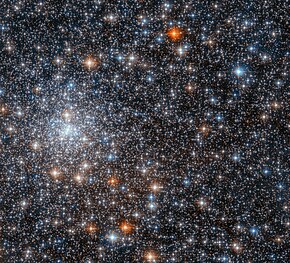
NGC 6558
| NGC 6558 | |
|---|---|
 The globular cluster NGC 6558 imaged by the Hubble Space Telescope | |
| Observation data (J2000 epoch) | |
| Class | V |
| Constellation | Sagittarius |
| Right ascension | 18h 10m 18.38s[1] |
| Declination | −31° 45′ 48.6″[1] |
| Distance | 24.1 kly (7.4 kpc)[1] |
| Apparent magnitude (V) | 11.29[1] |
| Physical characteristics | |
| Radius | 5.2' x 5.2'[2] |
| Metallicity | = -1.32[3] dex |
| Other designations | Cr 368, GCl 89, ESO 456-62, VDBH 259[1] |
NGC 6558 is a globular cluster, located about 24,000[4][a] light years away in the constellation Sagittarius. Its apparent magnitude is about 11 and its apparent diameter is about 10 arcminutes.[2] The globular cluster was discovered in 1784 by the astronomer William Herschel with his 18.7-inch telescope and the discovery was later catalogued in the New General Catalogue.

It is located 1.5 degrees south-southeast of Gamma2 Sagittarii.

References
- ^ a b c d e "NGC 6558". SIMBAD. Centre de données astronomiques de Strasbourg. Retrieved 8 January 2017.
- ^ a b "NGC 6558". Retrieved 8 January 2016.
- ^ "A Galactic Globular Clusters Database: NGC 6558". Retrieved 8 January 2017.
- ^ Souza, S. O.; Libralato, M.; Nardiello, D.; Kerber, L. O.; Ortolani, S.; Pérez-Villegas, A.; Oliveira, R. A. P.; Barbuy, B.; Bica, E.; Griggio, M.; Dias, B. (2024). "Combined Gemini-South and HST photometric analysis of the globular cluster NGC 6558. The age of the metal-poor population of the Galactic Bulge". arXiv:2407.15918 [astro-ph.GA].
In the literature, the heliocentric distance of NGC 6558 ranges from ∼6.3 kpc (Rich et al. 1998) to ∼8.3 kpc (Barbuy et al. 2018b).
- Notes
- ^ The central value in the range is 7.3 kiloparsecs (24,000 ly).
External links

See what we do next...
OR
By submitting your email or phone number, you're giving mschf permission to send you email and/or recurring marketing texts. Data rates may apply. Text stop to cancel, help for help.
Success: You're subscribed now !

![{\displaystyle {\begin{smallmatrix}\left[{\ce {Fe}}/{\ce {H}}\right]\end{smallmatrix}}}](https://wikimedia.org/api/rest_v1/media/math/render/svg/4c0821bd80891e071c08e7c7ee8e022baedf522c)